Archive for the ‘Threats from Tourism and Recreation’ Category
Wednesday, October 5th, 2011
Every year after summer and upon the onset of winter, the outdoor pool at Katoomba Sports and Aquatic Centre, situated in Central Blue Mountains, is drained. Its contents including the chlorine (likely sodium hypochlorite) is emptied. The adjacent old plumbing between the pool and the dam, as well as repeated conductivity tests by the editor over multiple years under the Sydney Catchment Authority Streamwatch Programme point to the drainage being into the adjacent dam and into the Kedumba River; not into the sewer..
Reports of extreme water conductivity (off the scale… 500+ micro Siemens/cm) in the dam immediately following the draining the pool scale were sent to the Sydney Catchment Authority (SCA) , but nothing was ever done about it by the SCA.
This means every year, thousands of litres of chlorinated pool water flushes over Katoomba Falls and along the Kedumba River through the Greater Blue Mountains World Heritage Area.
It is therefore no surprise then that the Kedumba River looks clean – Blue Mountains Council ensures it is sterile of macro-invertebrates and river life.
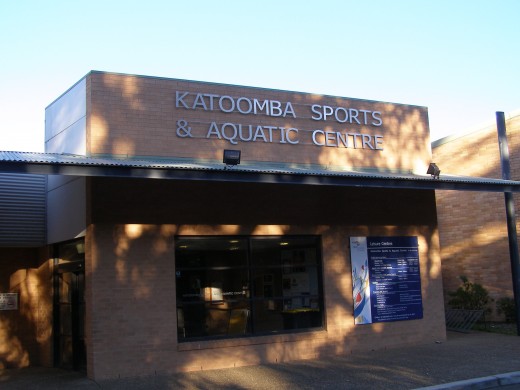 Katoomba Sports & Aquatic Centre
Blue Mountains, New South Wales, Australia Katoomba Sports & Aquatic Centre
Blue Mountains, New South Wales, Australia
.
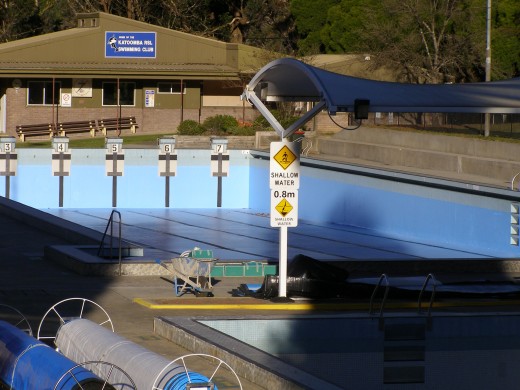 The Outdoor Pool of the Aquatic Centre…drained every winter
(Photo by Editor 20110516, free in public domain) The Outdoor Pool of the Aquatic Centre…drained every winter
(Photo by Editor 20110516, free in public domain)
.
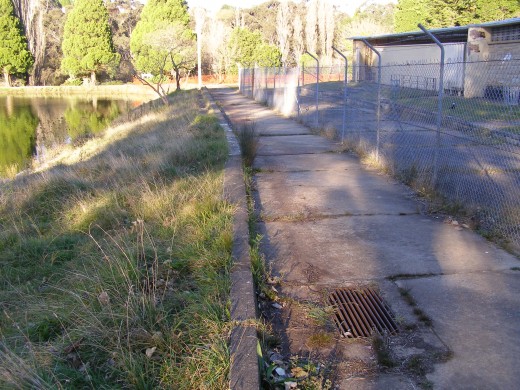 The Aquatic Centre was constructed conveniently adjacent to the Catalina Dam The Aquatic Centre was constructed conveniently adjacent to the Catalina Dam
.
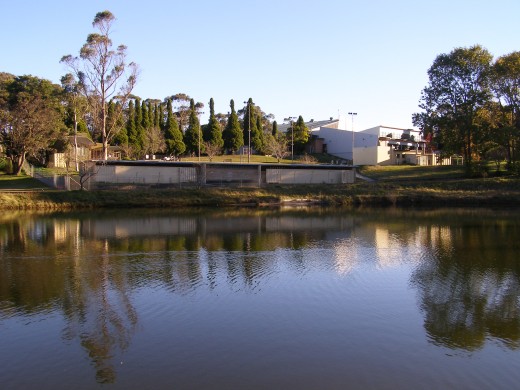 Catalina Dam, which in the late 1940s was glorified as a ‘lake’ by developer Horace Gates
Catalina Dam, which in the late 1940s was glorified as a ‘lake’ by developer Horace Gates
(designed with a flotation levelling system interconnected to adjacent Katoomba Falls Creek)
.
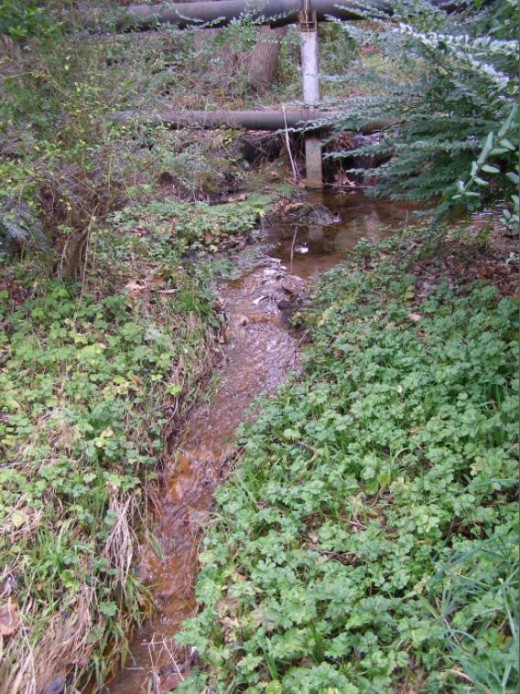 Upper Kedumba Creek downstream of Catalina Dam Upper Kedumba Creek downstream of Catalina Dam
.
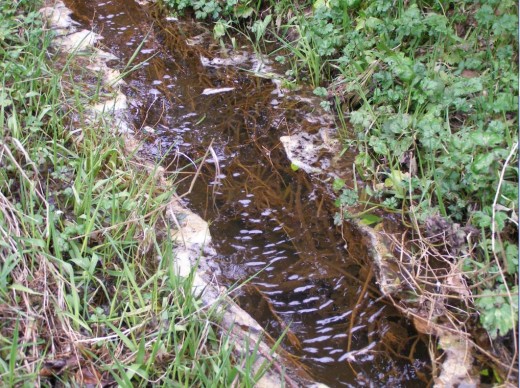 Upper Kedumba Creek downstream of Catalina Dam – close up Upper Kedumba Creek downstream of Catalina Dam – close up
.
 Katoomba Falls Creek naturally flows over Katoomba Falls Katoomba Falls Creek naturally flows over Katoomba Falls
.
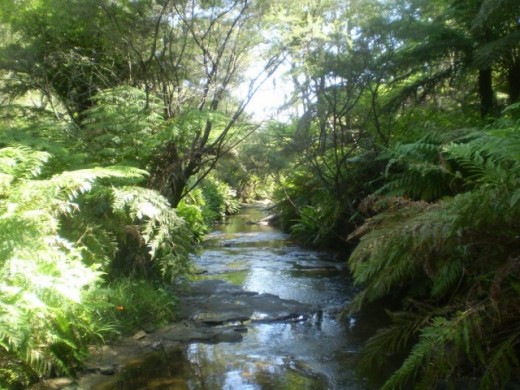 Katoomba Falls flows down the Blue Mountains escarpment into the Kedumba River Katoomba Falls flows down the Blue Mountains escarpment into the Kedumba River
.
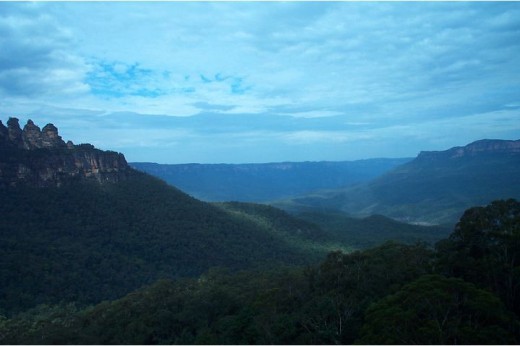 The Kedumba River flows through the Greater Blue Mountains World Heritage Area. The Kedumba River flows through the Greater Blue Mountains World Heritage Area.
Saturday, September 10th, 2011
[This article was initially published by Tigerquoll on CanDoBetter.net 20090518 under the title: ‘Repco Rally… driven by Rees’ selfish ‘Red Hot Go!‘. A few modifications have been made].
.
 Ex-NSW Premier, Nathan Rees
Photo: AAP, Sergio Dionisio Ex-NSW Premier, Nathan Rees
Photo: AAP, Sergio Dionisio
.
‘Freshly sworn in NSW Premier Nathan Rees MP back on 5th September 2008, recognising people are annoyed and frustrated with the State Government and proclaiming to have a ‘red hot go’ at fixing NSW. Rees says he recognises people are annoyed and frustrated with the State Government. [SOURCE: ABC 5-Sep-08]
Why do we tolerate it?
Why do politicians, as soon as they taste power, think they have rights akin to the kings of old, to splurge on personal fettishes and pet hobbies using taxpayers’ money and abuse the rights of local citizens?
In less than four weeks safter Rees took office, on Monday 29th September 2008, Rees’ personal passion for V8 racing saw him personally approve the unprecedented introduction of V8 Supercar racing at Sydney Olympic Park (Homebush) for five years despite strong local community opposition. Hardly a decision to address the people’s annoyance and frustration with the NSW Government.

Accompanied by a howl of boos from a small group of protesters, Rees overruled Homebush locals concerns about the required removal of 700 trees, significant noise and air pollution impacts, contamination of parklands waterways & habitat (including Green & Golden Bell Frog habitat) from fuel & oil spills, disturbance to native fauna from noise impacts & crowd movements and the unfair impost on local urban amenity & public open space. Our naive Nathan has been sold on hollow promises of “attracting 15,000 visitors and attracting $100 million to a desperate NSW economy. So desperate and naiive Nathan has grabbed the hype to get quick political wins. It is these ‘quick political wins’ that have shaped his tenure and that will shape his legacy. Long term State investment, that is investment beyond the next election cycle is not a mandate the NSW Labor Party has granted him.
[SOURCE: ^http://www.tec.org.au/index.php?Itemid=291&id=693&option=com_content&task=view]
.

The motor racing event is being promoted by Events NSW (an arm of the Rees NSW Government) and is set to be an annual event every December. The main sponsor is Telstra, which at the same time hypocritically declares on its corporate website that its “concern for the community and resolve to address environmental issues will only serve to improve Telstra’s future.”
.
.
.
.
In 2009 Repco imposed is car rally on the rural shires of Tweed and Kyogle
.
Then we see another motor racing event for NSW, the Repco Rally, relocated from where is has been staged for two decades outside Perth to the NSW in the Tweed and Kyogle shires in September. It is set to be staged every two years at least until 2017. Of course Rees has given it his red hot support and again his Events NSW is plugging it hard.
Again, NSW taxpayers are paying up to $8 million to the rally organizers and the Tweed Shire Council has promised to fund the rally organisers an extra $120,000 every two years out of local rates revenue. This funding comes at a time when the Rees government says it can’t afford to provide adequate local policing or health services to the people of the Tweed Shire.
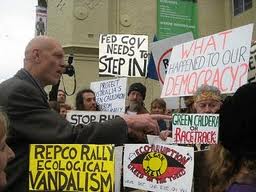
Layla Gain-Hill with residents of Barkers Vale and Wadevale who are concerned the Repco Rally with endanger Hanging Rock Creek. Photo courtesy of Mel McMillan and Northern Star newspaper 21st January 2009.
Many locals at both events have strongly and unanimously voiced their objections to these events respectively, but ‘king’ Rees likes his car racing and has proclaimed it’s all going ahead. It’s not too dissimilar to the English aristocracy of old pursuing fox hunts through farmers properties, thumbing their noses at the locals. Auburn, Parramatta and Ryde Councils all unanimously passed resolutions opposing the proposed V8 Supercar race at Homebush.
Both races will mean senseless environmental vandalism and are a blatant denial of local communities of their Common Law rights to quiet enjoyment and amenity. If the history of both races is any guide, Rees’ red hot go at promoting his car racing fetish is set to cost NSW more than the exaggerated hype of making money for NSW.

At a time when peak oil has been and gone and the motor car industry is in decline, Rees’ petrol head fetish can only be a selfish desire and an abuse of privilege and power to doggedly pursue an unsustainable 20th century motor racing culture. This is set to be Rees’ legacy of his red hot term in power.
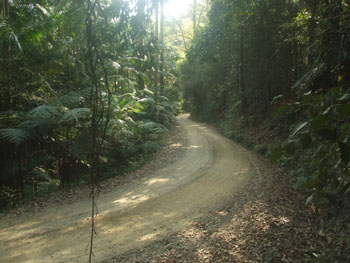 Repco Rally a high speed reckless route through tropical rainforest tracks Repco Rally a high speed reckless route through tropical rainforest tracks
.
Rees fetish for V8s should be tempered. The V8 race could more suitably staged at the existing dedicated motor racing circuit just down the road at Eastern Creek. Rees’ fetish for rally driving could be fed by him flying over to Perth where it used to be staged.’

.
.
‘Rees supporting Mad Max 4 – says it all!’
October 24th, 2009 Tigerquoll says:

‘Petrol head Nathan Rees was behind the Repco Rally and sorted political legislation to make it happen, same with V8 Supercars ripping through Homebush. So somehow I expected to see him supporting the forth Mad Max film being announced today for New South Wales. The original Mad Max was screened back in 1979.
As Rees sees it – simple – more jobs for mechanics, spray painters nd tourism – jobs, jobs, jobs. But film making is a one off. So like mining companies than come and go sacking workers as hey move on so will this film. Boom and bust mentality perpetuates like the 19th Century gold rush.
Now there digging up the 1970s for a remake. It’s like Bowie’s Life on Mars remastered. But I wish “Fury Road” every success for Australia’s struggling film industry, although can’t we find a new subject? How about a file called ‘Franklin’ with Australia’s best actors and emerging actors retelling the iconic environmental and social battle of Australia’s recent history? It would be new, fresh and topical.
Anyway, may be Mel s Max 4 may wish to do a Silvester Stalone come back. The NSW Film & Television Office is now part of Rees mega department Industry & Investment NSW. It all sounds energetic, but can someone name just one project out of it that is fully funded, approved and underway with a 5 year life or longer let alone beyond the NSW election cycle.
Nathan relishes any business announcement especially one that involves cars. Pity Bridgestone has suddenly announced closing up shop in South Australia with no thought to redeploying its 600 Australian employees.
Executive director of the Australian Institute for Social Research, Associate Professor John Spoehr, says “”We know from the past that around about one-third of manufacturing workers that lose their jobs during downturns go on to be long-term unemployed.”
[SOURCE: ^http://www.abc.net.au/news/stories/2009/10/24/2723176.htm]
.
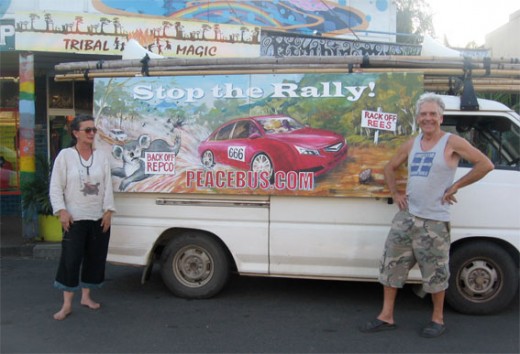
The writing is on the wall for the automotive industry in Australia, but some petrol heads just can’t give up the addiction and keep tuning into Top Gear ‘to keep the dream alive’.
Rees says ‘keep it simple stupid’! Well simple ideas for simple minds as other say. NSW has become the meat head state! May be I should change my number plate.’
 Petrol Head Inculcation
~ like irresponsible father, like pre-P-plating son. Petrol Head Inculcation
~ like irresponsible father, like pre-P-plating son.
.
 Another irresponsible P-plater after high speed in the rain
Albion (northern Brisbane, 2010)
[Read More] Another irresponsible P-plater after high speed in the rain
Albion (northern Brisbane, 2010)
[Read More]
.

.
.
Further Reading:
[1] Peacebus.com, ^ http://www.peacebus.com/NoRepcoRally/blog2009.html
[2] Fight against the Rally, CanDoBetter.net, ^ http://candobetter.net/blog/130
[3] Homebush V8 Event Slammed As Cost Blowout, ^ http://richardsf1.com/2010/06/23/homebush-v8-event-slammed-as-cost-blowout/
.
– end of article –
Sunday, September 4th, 2011
Whilst touring Tasmania’s highland country in 2009, we stopped over in the old rural town of Bothwell.
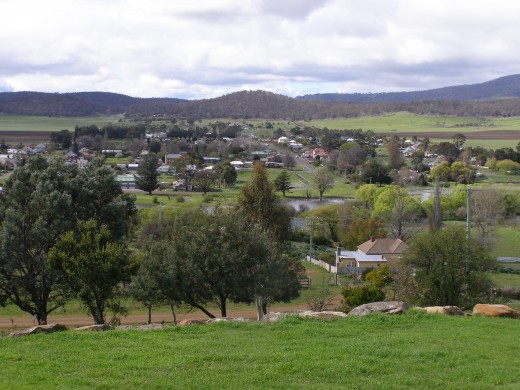 A pastoral Bothwell ~ an ode to the British countryside A pastoral Bothwell ~ an ode to the British countryside
looking from Barrack Hill over the River Clyde
(Photo by Editor 2009, free in Public Domain)
(click photo to enlarge, then again to enlarge again)
.
Bothwell is historically known for its colonial exploration dating back to 1806, its convict past dating back to the 1820’s, and for its soldiers’ barracks, and for its pastoral colonial heritage.
Its namesake was derived from a town in Lanarkshire, Scotland; likewise the naming of the River Clyde.
 Bothwell
Situated in the Tasmanian South East Bioregion Bothwell
Situated in the Tasmanian South East Bioregion
.
Few will know of the prior Tasmanian Aboriginal heritage of the 5 bands of the traditional Tasmanian tribe (kinship group) the ‘Teen Toomle Mennenyer‘ of this highland and river region. Many were either massacred, rounded up and put into missions, or succumbed to European diseases. Most were dispersed from their traditional lands by 1832. This otherwise labelled ‘Big River Tribe‘ likely due to the big river country characterising this fertile inland region; rivers of which subsequently named the Derwent, Ouse, Clyde, Shannon, Weld, Styx, Plenty, Jordan, Lake, Isis and Pine, amongst others.
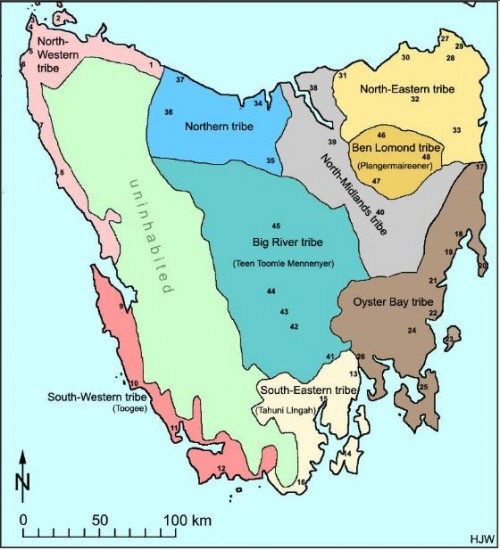 Traditional Aboriginal Territories of Tasmania Traditional Aboriginal Territories of Tasmania
.
Even fewer will know of the extensive tall Tasmanian Swamp Gum forest that for thousands for years blanketed this lush river valley, prior to it being clear-felled for timber and to make way for colonial pasture.
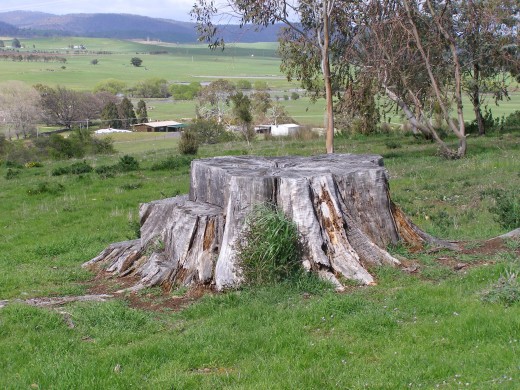 ‘Dead Heritage’
Stump of a Tasmanian Swamp Gum (Eucalyptus regnans)
on Barrack Hill, overlooking Bothwell
(Photo by Editor 2009, free in Public Domain
(click photo to enlarge, then again to enlarge again) ‘Dead Heritage’
Stump of a Tasmanian Swamp Gum (Eucalyptus regnans)
on Barrack Hill, overlooking Bothwell
(Photo by Editor 2009, free in Public Domain
(click photo to enlarge, then again to enlarge again)
.
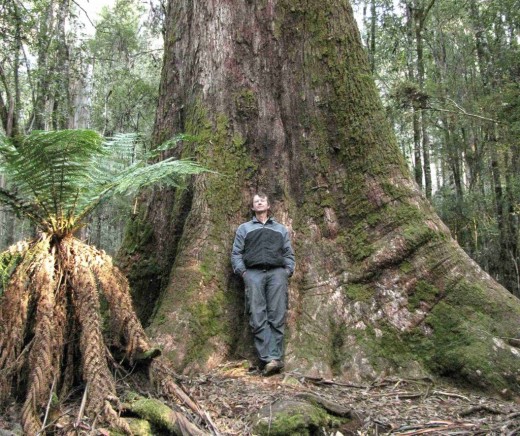 ‘Tasmanian Natural Heritage’
‘Tasmanian Natural Heritage’
Tasmanian Swamp Gum
The type of Swamp Gum forest around Bothwell
that would have greeted the colonists back in the 1820s
(© Photo Magi Nams)
Source: http://www.nams.ca/MagiBlog/tag/tasmanian-snow-gum/page/2/
.
.
Fifty kilometres down the road from Bothwell on the tourist drive, lies the old colonial town of Oatlands. The old Callington Flour Mill in the town has become a tourist attraction and has recently been restored aided by a $1.2 million grant by Australia’s Minister for Trade, Simon Crean, in 2007.
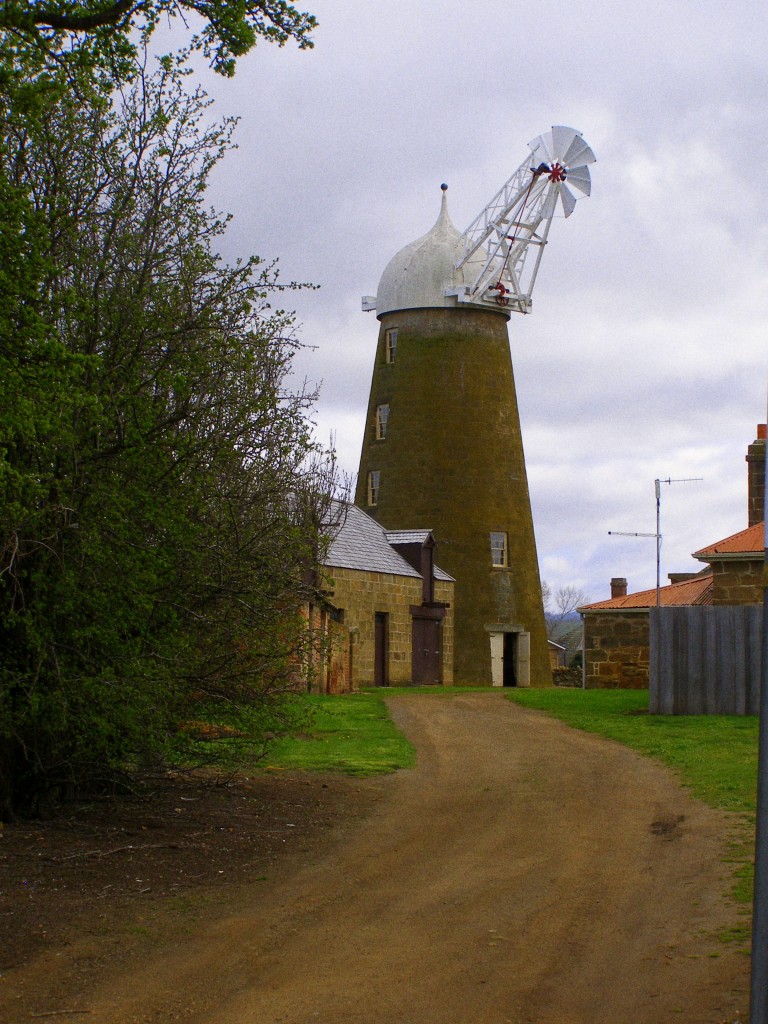 ‘Tasmanian Colonial Heritage’
Oatlands’ Wind Mill
The 1837 landmark Callington Flour Mill, recently restored
(Photo by editor, September 2009, free in Public Domain)
‘Tasmanian Colonial Heritage’
Oatlands’ Wind Mill
The 1837 landmark Callington Flour Mill, recently restored
(Photo by editor, September 2009, free in Public Domain)
.
Part of that restoration involved adding new structural posts in its interior. The following photo is of a rather new looking hardwood post inside the mill. It looks like local Messmate/Stringybark (Eucalyptus obliqua), generically marketed as ‘Tasmanian Oak‘.
.
Other local timbers sold as ‘Tasmanian Oak’ are Alpine Ash (Eucalyptus delegatensis) and Swamp Gum (Eucalyptus regnans).
On Mainland Australia, Eucalytus regnans is referred to as Mountain Ash ~ once the world’s tallest tree species, once taller than the Californian Redwood.
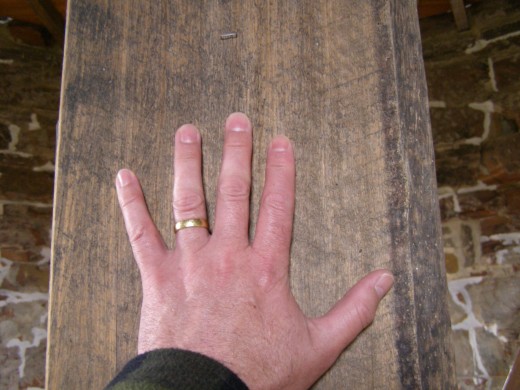 The environmental cost of Tasmanian Tourism
A new ten inch (wide) post inside Oatlands’ restored mill,
probably from local Messmate/Stringybark (Eucalyptus obliqua)
(Photo by editor, September 2009, free in Public Domain)
. The environmental cost of Tasmanian Tourism
A new ten inch (wide) post inside Oatlands’ restored mill,
probably from local Messmate/Stringybark (Eucalyptus obliqua)
(Photo by editor, September 2009, free in Public Domain)
.
.
.
.
.
Further Reading:
.
[1] ‘The Traditional Tasmanians‘, ^http://www.andaman.org/BOOK/chapter52/5-Tasmania-traditional/traditional.htm [Read More]
.
– end of article –
.
Tags: Big River Tribe, Bothwell, Dead Heritage, Eucalyptus globulus, forgotten forest, Oatlands' Callington flour mill, stump heritage, Tasmania, Tasmanian Aborigines, Tasmanian Blue Gum, Tasmanian Natural Heritage, Tasmanian South East Bioregion
Posted in Tasmania (AU), Threats from Deforestation, Threats from Tourism and Recreation, Threats to Wild Tasmania | No Comments »
Add this post to Del.icio.us - Digg
Friday, July 22nd, 2011
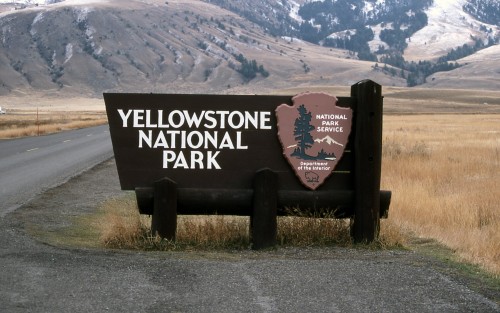 A proper ‘National Park” – Yellowstone National Park, USA A proper ‘National Park” – Yellowstone National Park, USA
© Photo by Jim Peaco, October 1992
[Source: http://www.longislandpress.com/wp-content/uploads/2011/07/14566-1.jpg]
.
One hundred and thirty nine years ago in 1872, Yellowstone National Park was established in the United States of America, leading the world in national conservation..
Australia supposedly followed suit quickly afterwards in 1879, declaring The National Park just south of Sydney the second national park in the world. It was renamed Royal National Park following Queen Elizabeth II’s visit in 1954.
But it is one thing to be seen to be following America in environmental leadership. It is publicly misleading to be disingenuous about ‘national‘ environmental protection.
 A ‘vulnerable’ Royal National Park (New South Wales, Australia)…
. A ‘vulnerable’ Royal National Park (New South Wales, Australia)…
.
National Parks in New South Wales are currently subject to the whims of incumbent State governments (both Labor and Liberal) and mining vested interests with such demands as to explore coal seam gas mining using fracking and chemical contamination from the likes of Apex Energy and Peabody Pacific’s joint Metropolitan Mine near Helensburgh in 2010.
National parks are typically large natural areas of land that are protected because they have unspoilt landscapes and a diverse number of native plants and animals. This means that commercial activities such as farming are prohibited and human activity is strictly monitored. The purpose of the ‘national parks’ concept is to protect native flora and fauna and their habitat.
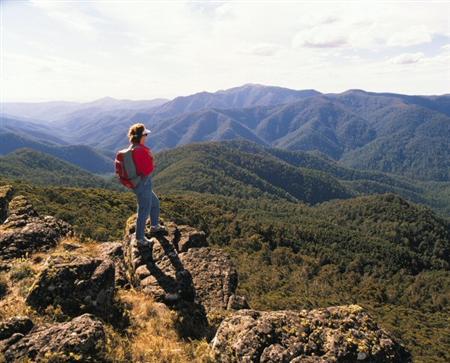 Victorian Alps Victorian Alps
.
Disturbingly, the powers that be in National Parks have grown a mindset that national parks are created primarily not for altruistic genuine conservation but for tourism – human use, benefit and exploitation. The sell is that national parks “are also there so Australians and foreign visitors can enjoy and learn about our unique environment, heritage and culture.”
Australia has over 500 national parks covering some 28 million hectares accounting for 4% of Australia’s land mass. But similarly disturbing is that the Australia legal concept of a ‘national park’ is one typically managed not by the national government, but a custodial responsibility delegated to the States and Territories of Australia. This means that across Australia, national parks are a hollow label for ‘reserve’, or in the case of Victoria’s Alpine National Park, an endless free cow paddock!
 Cattle in the Alpine National Park?
© Photo Trevor Pinder Herald Sun 20110412 Cattle in the Alpine National Park?
© Photo Trevor Pinder Herald Sun 20110412
.
The state/territory custodial role for national parks is a left-over legacy from pre-Federation colonial Australia of the Nineteenth Century, in much the same way the Crown Land is a leftover legacy from when the Australian colonies were subservient to Britain. And sure enough, the management records demonstrate that the spirit of national park protection has not been respected by the state and territory custodial governments.
National Park ‘protection’ in the United States has national clout. But in Australia the term is politically expedient and superficial. This has caused the conservation movement to increasingly look to UNESCO World Heritage, because state and territory governments cannoit be trusted. ‘National park’ status has become meaningless. Just consider the Kakadu, Kosciuszko, and the Great Barrier Reef national parks and their abuse and mismanagement legacies!
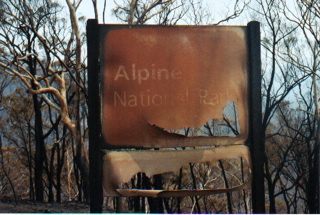 Alpine National Park
10,000 hectares was allowed to burn in 2003
~ so much for National Park ‘protection’, more like ‘abandonment’. Alpine National Park
10,000 hectares was allowed to burn in 2003
~ so much for National Park ‘protection’, more like ‘abandonment’.
.
.
Media Release by the National Parks Association of NSW:
[22 July 2011]
.
‘National Parks to be given national status’
.
National Parks Association of NSW CEO, Kevin Evans, has welcomed moves by Federal environment minister Tony Burke to add Commonwealth protection to Australia’s national parks.
“Stronger Federal protection for national parks is a groundbreaking move that will ensure the long-term integrity of Australia’s most loved natural places and vital habitat for threatened plants and animals,” Mr. Evans said.
“It will also make sure that politically motivated interference in park protection, including proposals for inappropriate tourism infrastructure, mining, cattle grazing and hunting will be more difficult in the future.
“We need to be clear that such proposals are not in the national interest,” Mr. Evans said. “Our protected areas are part of much bigger systems working at a landscape scale as the corner stone of Australia’s biodiversity conservation strategy.”
Speaking at the Sydney Institute on Thursday evening, Mr. Burke said “that there was a principle that once an area was protected there shall be no backward steps”.
He referred to the move by the Victorian government to return cattle to the Alpine National Parks earlier this year as treating a national park like a farm.
“Importantly, if implemented, this proposal would allow Australia to honour its commitment to international treaties designed to protect the world’s natural heritage” Mr. Evans said.
“It won’t change the way national parks are managed but as the minister says, it will make sure that there will be ‘no backward steps’ in that management.
“Most people already assume that national parks have national protection, as they do in most countries of the world. But almost all of our most important natural areas are actually set up and managed under the laws of each state and territory.”
Minister Burke announced last night that he has written to all states and territories seeking their views on a plan to amend federal laws to better protect national parks.
NPA encourages the NSW government to cooperate with the Federal environment minister on his proposal.
“Under the proposed federal law, states will still be in control of setting park boundaries, and there will be no change to existing activities in parks,” said Mr. Evans.
Mr. Evans said,
“What it does mean is that the protection offered by state laws will be backed up by national law.”
Our national parks will be truly part of our national heritage, securely protected by all Australians, for all Australians, for all time.
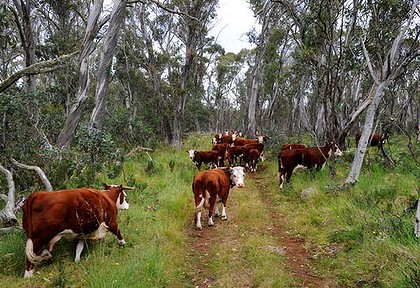
.
.
Editor’s comments:
This revelation confirms that Australians have been hoodwinked about ‘National Park Protection’ since 1879.
It one of the biggest greenwashing cons in Australian history. National Parks are but a convenient propaganda label until alternative land use demands are proposed.
The message is that the States and Territories simply cannot be trusted with Australia’s valuable natural heritage.
So if such jurisdictions are so unrepresentative of Australian values, then why do the States and Territories continue to exist?
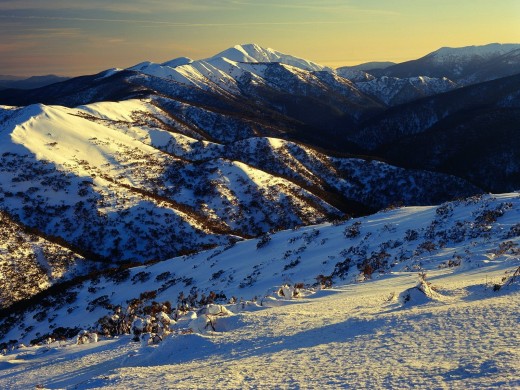 Sunrise on Mount Feathertop, Alpine National Park, Victoria
© http://good-wallpapers.com/places/4689. Sunrise on Mount Feathertop, Alpine National Park, Victoria
© http://good-wallpapers.com/places/4689.
.
.
Background:
.
‘High country ought stay a cattle no-go zone’
by Geoff Mosley, 20110308, The Age
.
‘The Baillieu government’s decision to reintroduce cattle into the Alpine National Park not only snubs 80 years of research highlighting the environmental damage they can do, it also undermines co-operative management of Australia’s alpine parks. This move was undertaken without any consultation with the federal government and, since the Alpine National Park is on the National Heritage List, all eyes are on whether Environment Minister Tony Burke will intervene to protect the area’s nationally significant natural heritage values.
 Victorian Premier, Ted Ballieu
© Sunday Herald Sun, 20110424 Victorian Premier, Ted Ballieu
© Sunday Herald Sun, 20110424
.
In deciding, Burke must take into account strong opposition to the Baillieu government’s move from the Australian Academy of Science and the World Commission on Protected Areas. These organisations have pointed to the bad example it would set when more than 3000 people attend the World National Parks Congress in Melbourne in 2014.
The planned ‘‘study’’ was also criticised by Melbourne University’s School of Land and Environment, whose acting head, associate professor Gerd Bossinger, said in an email: ‘‘much of the work being proposed has already been done’’. This response elicited a threat from the Baillieu government over millions of dollars in research funding.
Burke should also consider the damage that Victoria’s action would do to the co-ordinated approach to interstate management of the alpine parks, which has operated since 1986.
The states have been in charge of public land, including national parks, which by then had been established in several states, since Federation in 1901. Federation also introduced a possible role for the federal government in encouraging co-operative endeavours in heritage protection.
Co-operation did not come easily. The first initiative for a cross-state national park in the Alps came from the environment movement.
But, in 1943, the Victorian government rejected the proposed ‘Snowy-Indi National Park‘, embracing parts of the NSW (17,200 ha) and Victoria’s high country (22,000 ha), because of the ‘‘dangers to which large areas of country would be exposed by prohibiting occupation’’ – whatever that meant.
Instead the individual states established separate protected areas in their territories – Kosciusko State Park in 1944 (which became Kosciusko National Park in 1967), Gudgenby Nature Reserve in 1979 (became Namadgi National Park in 1984), and the Alpine National Park (formed from several disparate parks) in 1989.
The case for co-operative management of these adjacent alpine parks was obvious but who would initiate it?
The potential for Commonwealth leadership in such an enterprise was greatly increased in the 1970s with the passage of legislation to protect the national estate and with Australia’s ratification in 1974 of the World Heritage Convention. Apart from Queensland’s Great Barrier Reef and south-west Tasmania, there appeared to be no part of Australia more deserving of such a federal commitment than the Alps.
A clear case in point was the need for a uniform approach to alpine grazing. NSW ended the practice in Kosciusko National Park in 1969. The ACT followed suit. But the Victorian government dithered. So in 1984, I, as then director of the Australian Conservation Foundation, took 15 Victorian MPs on a tour of Kosciusko National Park. The visitors were so impressed by the recovery of the land after the removal of grazing that they agreed on a ‘‘Memorandum of Understanding for Co-operative Management of the Australian Alps National Parks’’, signed on July 15, 1986.
After an extensive review, in 2006 the Victorian government terminated the last of several of grazing licences in the Alpine National Park, bringing the state into line with NSW and the ACT. The Baillieu government’s reintroduction of grazing puts this hard-won co-operation in jeopardy.
Tony Burke’s decision also has consequences for the fate of the world heritage-listing proposal, in limbo since prime minister Bob Hawke announced in 1989 that the Australian Alps would be assessed.
World heritage listing of the Alps and adjacent forests – the ‘‘sea to snow concept’’ – would give the federal government enhanced power to act as Hawke did in 1983 to stop the Franklin Dam in Tasmania’s Wilderness World Heritage Area. Five reports later and nothing has happened. Meanwhile, the presence of cattle in the Alpine National Park could mean that a nomination would fail the ‘‘integrity’’ test for listing.
Burke has an opportunity to not only protect the Alpine National Park but to advance the overall cause of national heritage protection. If the word ‘‘national’’ means anything, he must do the right thing by the people of Australia and send the cattle back down the hill.’
– – – – – – – – – –
[Geoff Mosley has been involved with establishing and management national parks in the alpine areas of ACT, New South Wales and Victoria for 50 years. He was chief executive of the Australian Conservation Foundation from 1973 to 1986 and remains a member of the ACF council.]

.
.
.
Further Reading:
.
[1] ‘Burke demands a halt to alpine cattle grazing‘, 20110318, ABC Rural, ^http://www.abc.net.au/rural/news/content/201103/s3167854.htm
[2] ‘High country ought stay a cattle no-go zone‘, by Geoff Mosley, 20110308, ^http://www.smh.com.au/opinion/high-country-ought-stay-a-cattle-nogo-zone-20110307-1bka1.html
[3] ‘ Cattle Don’t Belong in Parks‘, Victorian National Parks Association ^ http://vnpa.org.au/page/bushwalking-and-activities/events/public-meeting-_-cattle-don%27t-belong-in-parks
[4] ‘ Coal Seam Gas Mining Threatens NSW and Australia‘, ^ http://www.stopcoalseamgas.com/helensburgh.php
[5] ‘ Wildlife under threat from shooters in NSW‘ (National Parks), ^ http://www.animalsaustralia.org/take_action/wildlife-under-threat-from-shooters–in-NSW/
[6] ‘ Uranium mining in Kakadu National Park‘, ^ http://en.wikipedia.org/wiki/Uranium_mining_in_Kakadu_National_Park
[7] ‘ Great Barrier Reef Environmental Threats‘ ^ http://www.workincairns.com/great-barrier-reef/environmental-threats.asp
[8] ‘ Human Impact on the Great Barrier Reef‘, University of Michigan, ^ http://sitemaker.umich.edu/gc2sec7labgroup3/pollution
.
(All references accessed 20110722)
.
22 July 2011
National Parks to be given national status
National Parks Association of NSW CEO, Kevin Evans, has welcomed moves by Federal environment minister Tony Burke to add Commonwealth protection to Australia’s national parks.
“Stronger Federal protection for national parks is a groundbreaking move that will ensure the long-term integrity of Australia’s most loved natural places and vital habitat for threatened plants and animals,” Mr. Evans said.
“It will also make sure that politically motivated interference in park protection, including proposals for inappropriate tourism infrastructure, mining, cattle grazing and hunting will be more difficult in the future.
“We need to be clear that such proposals are not in the national interest,” Mr. Evans said. “Our protected areas are part of much bigger systems working at a landscape scale as the corner stone of Australia’s biodiversity conservation strategy.”
Speaking at the Sydney Institute on Thursday evening, Mr. Burke said “that there was a principle that once an area was protected there shall be no backward steps”. He referred to the move by the Victorian government to return cattle to the Alpine National Parks earlier this year as treating a national park like a farm.
“Importantly, if implemented, this proposal would allow Australia to honour its commitment to international treaties designed to protect the world’s natural heritage” Mr. Evans said.
“It won’t change the way national parks are managed but as the minister says, it will make sure that there will be ‘no backward steps’ in that management.
“Most people already assume that national parks have national protection, as they do in most countries of the world. But almost all of our most important natural areas are actually set up and managed under the laws of each state and territory.”
Minister Burke announced last night that he has written to all states and territories seeking their views on a plan to amend federal laws to better protect national parks.
NPA encourages the NSW government to cooperate with the Federal environment minister on his proposal.
“Under the proposed federal law, states will still be in control of setting park boundaries, and there will be no change to existing activities in parks,” said Mr. Evans.
Mr. Evans said, “What it does mean is that the protection offered by state laws will be backed up by national law. Our national parks will be truly part of our national heritage, securely protected by all Australians, for all Australians, for all time.
“It will be good for nature protection and good for ecologically sustainable tourism,” said Mr. Evans.
Tags: Alpine National Park, Baillieu government, Cattle in the Alpine National Park, Cattle no-go zone, national parks, National Parks Association of NSW, NPA, Tony Burke, Victoria's High Country, World National Parks Congress 2014
Posted in Australian Alps (AU), Threats from Farming, Threats from Greenwashing, Threats from Mining, Threats from Tourism and Recreation | No Comments »
Add this post to Del.icio.us - Digg
Tuesday, May 3rd, 2011
 Fraser Island Dingo
[Source: ^http://widebaygreens.org/fraser-island/] Fraser Island Dingo
[Source: ^http://widebaygreens.org/fraser-island/]
.
‘The dingo population on (Fraser) island is regarded as the most pure strain of dingoes remaining in eastern Australia’.
~ ^UNESCO World Heritage
.
‘Dingoes were once common on the island, but are now decreasing. They are some of the last remaining pure dingoes in Eastern Australia and to prevent cross-breeding, dogs are not allowed on the island. There was no recorded history of dingoes attacking humans on Fraser Island up until 1995.
In April 2001, a boy wandered away from his family and was discovered dead, with indications of a dingo attack. Thirty-one dingoes were killed by authorities as a result of the incident. In 2004, a dingo entered a hotel room on the island where a baby was lying on a bed. It was chased off before any incident occurred. Feeding or attracting the attention of dingoes remains illegal.
The remaining number of dingoes on the island is estimated to be 120 to 150 as of January 2008 and sightings are becoming rarer.’
[Source: ^ http://widebaygreens.org/fraser-island/]
.
.
.
Need to Control Humans
.
Given the recent history of parental negligence on Fraser Island, has it got to the point of mandating an ‘Adults Only’ responsible presence on Fraser Island?
Such a respectful ecological policy would ensure that only responsible human adults share and respect Fraser Island without risking more starving dingos to be shot in some twisted vengeance by so-called ‘wildlife officers’.
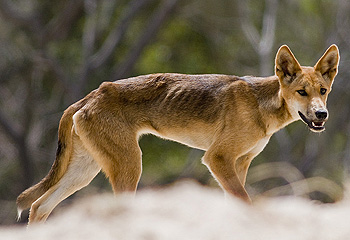 Australia’s national disgrace – starving dingos cornered on their native Fraser Island
[Source: ^http://www.care2.com/news/member/525884267/1440667] Australia’s national disgrace – starving dingos cornered on their native Fraser Island
[Source: ^http://www.care2.com/news/member/525884267/1440667]
.
What is the Queensland Government’s latest brand name for its agency responsible for Fraser Island’s supposed World Heritage values? – ‘Department of Environmental Resource Management‘ – who’s flaming resource? Is Queensland still redneck about tourism revenue and exploitation of this World Heritage tourism brand?.
Dingos are wild Australian animals.
Why haven’t Australian tourists learnt from Australia’s Azaria Lesson that children and wildlife don’t mix?
“The Fraser Island Dingo is believed to be the purest strain of Dingo on the East Coast of Australia. It is illegal to feed or touch the Dingoes as it causes the animals to become “humanised”. There have been recorded instances of Dingoes attacking humans with the fatal attack of a 9 year old boy. This is not a regular occurence and if people are aware of the danger then these instances can be minimised.”
[Source: ^http://ozmagic2.homestead.com/dingo.html]
.
.
.
Need to Restore Dingo Ecology on Fraser Island
.
The problem of the health, viability and survivability of Fraser Island Dingos is a joint responsibility of the Queensland Government and Australian Government.
Why the deliberate slaughter of dingos by the very Government agency charged with Fraser Island’s ecological integrity: ‘Department of Environmental Resource Management‘?
‘The recent slaughter of a very large number of one of the last genetically pure populations of dingoes in Australia (on Fraser Island) has prompted an overwhelming call by our member organisations to press for better protection for dingoes, both from acts of State-sanctioned cruelty and from the extreme and urgent threat of extinction.’
[Source: ^http://www.awpc.org.au/other_fauna/dingo1.htm]
 Starved dingo pup found on Fraser Island
Photo by local resident Judy Daniel, 2010
[Source: ^http://www.abc.net.au/news/stories/2010/03/30/2859757.htm] Starved dingo pup found on Fraser Island
Photo by local resident Judy Daniel, 2010
[Source: ^http://www.abc.net.au/news/stories/2010/03/30/2859757.htm]
.
.
Further Reading:
.
.
The Australian Dingo (or ‘Warrigal’) – a species deserving protection
.
[1] Fraser Island (UNESCO World Heritage) website, ^ http://whc.unesco.org/en/list/630
[2] ‘ Dingo protected in Victoria‘,20081024,
^http://www.abc.net.au/news/stories/2008/10/24/2400546.htm
.
.
Dingos are wild native animals
.
[3] ‘ Girl, 3, bitten by dingo at Fraser Island‘, ^ girl-3-mauled-by-dingo-at-fraser-island
[4] ‘ Dingo attacks child on Fraser Island‘, 20090807, ^ dingo-attacks-child-on-fraser-island
[5] ‘ Dingo attacks Fraser Island tourist‘, 20110121, ^dingo-attacks-fraser-island-tourist
[6] ‘ Dingo attacks tourist on Fraser Island‘, ^ dingo-attacks-tourist-on-fraser-island
[7] Lindy Chamberlain-Creighton website, ^ http://www.lindychamberlain.com/content/home
[8] ‘ Dingo attacks in Australia‘, ^ http://en.wikipedia.org/wiki/Dingo_attacks_in_Australia
[9] ‘ Dingo ‘superpack’ roams Fraser Island‘, ^ http://www.uq.edu.au/news/?article=5856
[10] ‘ Fears tourists’ dingo interaction threatens camping‘, Kallee Buchanan 20100316, ABC News,
^http://www.abc.net.au/news/stories/2010/03/16/2846964.htm
.
.
Saving Fraser Island Dingos
.
[11] ‘ Dingo enthusiast Jennifer Parkhurst fined $40k for feeding animals on Fraser Island‘,
Kristin Shorten, The Courier-Mail, Brisbane, 20101104, ^woman-fined-40k-for-feeding-dingoes
^
[12] ‘ I’m shattered, says dingo raid protester‘, 20090907, The Noosa Journal, Australia,
^http://animals-in-the-news.blogspot.com/2009/09/inval-overheid-in-woning-fraser-island.html
[13] ‘ Battle over the fate of Fraser Island’s dingoes‘, 20110108, Sydney Morning Herald,
^ battle-over-the-fate-of-fraser-islands-dingoes
[14] ‘ Dingo Management‘, ^ http://www.derm.qld.gov.au/parks/fraser/fraser-island-dingoes.html
[15] ‘ Fraser Island dingoes face extinction‘, Glenis Green, The Courier-Mail (newspaper), Brisbane, 20090523,
^ fraser-island-dingoes-face-extinction
[16] Fraser Island Footprints, ^ http://www.fraserislandfootprints.com/wp/?page_id=713
[17] Fraser Island Dingos Organisation (FIDO) website, ^ http://www.fido.org.au/
[18] ‘ A Draft Dingo Management Strategy for Fraser Island‘, FIDO website,
^http://www.fido.org.au/DingoManagement.html
[19] ‘Values of Fraser Island Tourism‘, FIDO website,
^http://www.fido.org.au/values-of-fraser-tourism.html
[20] Fraser Island Management Committee,
^http://www.tonycharters.com/heritage.html#CampingFraser
[21] ‘ Nomination of the Dingo as a threatened species‘, 2001, Australian Wildlife Protection Council,
^http://www.awpc.org.au/other_fauna/dingo1.htm
[22] ‘ Tourism operators criticise LNP Fraser Island plan‘, Kallee Buchanan, ABC TV News, 20100902,
^http://www.abc.net.au/news/stories/2010/09/02/3000360.htm
[23] ‘ Saving our wildlife from urban sprawl‘, 20101224, EcoNews.org.au,
^http://econews.org.au/2010/12/saving-our-wildlife-from-urban-sprawl/
[24] Fraser Island, ^ http://widebaygreens.org/fraser-island/
.
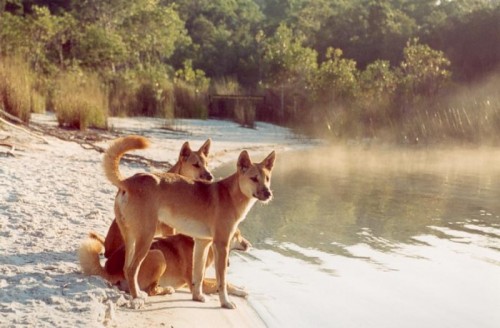
Wild dingos on Fraser Island
..deserve a healthy viable ecosystem, deserve to be left alone.
[Source: ^http://ozmagic2.homestead.com/dingo.html]
.
– end of article –
Tags: Azaria Lesson, dingo attacks, dingo ecology, dingo extinction risk, dingo persecution, dingos and children don't mix, Fraser Island dingo, Fraser Island tourism, Louise Parkhurst, pure dingo, The Fraser Island (Great Sandy Region), warrigal, World Heritage Fraser Island
Posted in Dingoes, Threats from Poaching and Poisoning, Threats from Tourism and Recreation | 1 Comment »
Add this post to Del.icio.us - Digg
Wednesday, May 26th, 2010
by Editor 20100526.
So what has the long trusted conservation brand of the National Parks and Wildlife Service come to represent in New South Wales?

Does tourism and revenue matter more than conservation?
The NSW Keneally Government’s Tourism Bill threatens to introduce specific tourist development provisions into the National Parks and Wildlife Act, 1974, including a long shopping list of facilities to allow for such things as fast food joints, supermarkets, golf courses, rifle ranges, conference centres and resorts of all sorts. It is tantamount to prostituting our National Parks. Instead of Parks and Wildlife being the custodian of wildlife and wilderness, it will become an ‘eco-pimp‘ – procuring visitation to protected areas that exploits and harms fragile ecology for commercial gain.
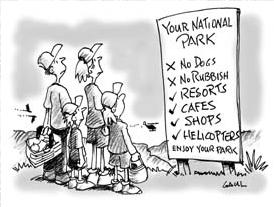
Keneally’s eco-pimp bill threatens to prevent future court appeals against bad developments in our precious National Park. Our Courts should retain the power to thrown out developments, such as private universities and wedding reception centres that don’t belong in our national parks.
Like the precursor Part 3A Planning tyranny bill before it, Keneally’s eco-pimp bill invites construction of new private accommodation facilities inside National Parks.
There is no evidence whatsoever to support the notion that private development in national parks will boost the tourism industry or provide extra funds for park management. A stronger nature tourism industry for NSW with more people enjoying the parks is best achieved by encouraging tourism investment in nearby towns where it most benefits regional communities.
There should be bi-partisan support to strengthen national park laws, not to weaken protection so as to facilitate commercial development. With our rapidly growing population, the integrity and protection of our parks is more important now than ever before.
The cost of visiting National Parks should remain small, to ensure parks can be accessible to all.
The environmental credentials of any party that supports Keneally’s Exploitation Bill, or any aspect of it, would be permanently tainted.
Keneally is blind to the motives of this anti-environment bill. Take her out of her sheltered urban environment and to experience some of our magnificent wilderness first hand may allow her to realise the precious values of the natural world and the wicked folly of this bill.
© The Habitat Advocate Public Domain
Tuesday, May 25th, 2010
by Editor 20100525.
At the end of April a copy of the “National Parks and Wildlife (Sustainable Tourism) Bill, 2010” came into the possession of the Colong Foundation. This Bill introduces specific tourism provisions into the National Parks and Wildlife Act, 1974, including a long shopping list of development opportunities that would permit fast food joints, supermarkets, wedding reception centres, conference centres and resorts of all sorts.
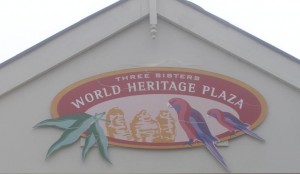
The Colong Foundation sought the advice and assistance of Mr Tim Robertson SC, who in 2004 so admirably defended the Grose Wilderness from exclusive occupation by Fox Studios. Justice Lloyd in his judgment on that case found that the production commercial feature film “Stealth” (about rouge military aircraft), “has nothing to do” with the National Parks and Wildlife Act’s objects or the purpose for reserving land as National Park. The case was thrown out Court, but not until after several local conservationists had been arrested defending wilderness.
If this “Sus. Tourism Bill” is passed, then the legal action to stop “Stealth-type” activities will be virtually impossible and bad developments will sprout up in our precious National Parks.
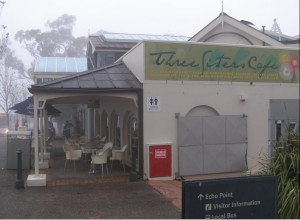
The whole point of these changes is to destroy the nexus between uses of the national park and the conservation purposes for which the park was reserved, and the power of the Court to adjudicate on whether the Minister’s decision accords with those purposes. Under these new laws, it is the Minister, and not the Courts, who will decide whether a use accords with the Park’s purpose.
Mr Robertson advised that the proposed legislation “removes the legal protection of National Parks from uses which damage their ecology and landscapes, by destroying the principle that National Parks can only be used for a purpose which promotes the use of the land as a public park. It provides the legal authority for the privatisation of National Parks by enabling exclusive possession rights to be given for commercial purposes to private interests under the broad rubric of sustainable tourism. Under this rubric, National Parks will be able to be used for general tourist purposes, such as tourist resorts, convention centres, shopping centres, fast food outlets, sporting activities and fun parks, at the discretion of the Minister, even where those uses do not promote the conservation of the Parks.”
The tourist industry grab for land rights over National Parks has to be stopped. Environment groups will be taking the issue to the people at the Penrith by-election and through the media.
Given the Coalition’s stance on Part 3A planning laws, it seems unlikely that the Coalition Parties will support these new park laws. The Shadow Environment Minister, Catherine Cusack wrote to the Nature Conservation Council in November 2009 and advised that she and the then Shadow Tourism Minister, Don Page, “do not support private accommodation facilities inside National Parks.”
The NSW Government should act to strengthen national park laws as they have repeatedly promised to do, not weaken them to facilitate commercial development. National Parks and Wildlife should not be selecting development sites in parks with the aim of offering these sites to the tourism industry in an “investor-ready” form. Our parks should not become profit centres for developers.

There is no evidence whatsoever to support the notion that private development in national parks will boost the tourism industry or provide extra funds for park management. A stronger nature tourism industry for NSW with more people enjoying the parks is best achieved by encouraging tourism investment in nearby towns where it most benefits regional communities.
With our rapidly growing population, the integrity and protection of our parks is more important now than ever before.
How is it that the Coalition Parties seems capable of grasping these ideas, while the NSW Labor Government remains unresponsive?
Keith Muir, Director, Colong Foundation for Wilderness
Sydney, Australia
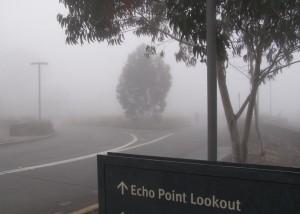
© The Habitat Advocate Public Domain
Friday, May 21st, 2010
by Editor 20100521.
a poem….

– – –
A Scribbly Gum here I stand
My species iconic, proud, but now condemned
They cast the red die on my girth, the red mark of death
So numbingly final
Glazed thoughts I can only muster
My roots here so ancient, means nothing to them
Scribblies flourished this land since Gondwana dawn
Pervading this old stone country high and deep
– – –
Once a wild place
A natural order, virgin and vast
Of times past, these primitive escarpments hosted wilderness
When old men Scribby Gums knew no saw
– – –
Came the getters, the settlers, the saws
For conquest, for progress, for their plot with a view
Wilderness they castrate, deemed it ‘battleaxe’
Ridges and valleys to the slaughter
Slaughter they sanitized, deemed it ‘clearing’
– – –
Some saw the wrong
Some good laws got through
Some Scribblies saved from slaughter
So why not protect me now?
– – –
Heritage denied me just trees away
Relegated from their Listing, on the fringe
Zoned a resource, a fuel, a hazard
Decisions cast from the Hill, to serve those from distant hills
Now they reason I block their view, I block their way
They cast the red die on my girth, the red mark of death
– – –
I’ll miss the rain most, the best time
When nature regains control
When the cloud drifts in, when it feels wild again
And dark rumblings roam and flare above
Dousing me in soaking cloud
Wild escarpment days
– – –
Motors approach. They come for me
Only a bus, it slows, they take photos, it groans away
Quiet again
– – –
Below the cloud, a piercing sunset glows my bark gold
Down the valley, the bush blanket surges
A breeze rising up the escarpment, fans me fresh
Around me branches sway, then settle, restful
Still again,
Quiet again
– – –
Soon they come
They cast the red die on my girth, the red mark of death
My death an extinction wedge
When they scatter my woodchips on their plot
Will they know I was once a Scribbly Gum – free and wild?
Their photos will torment of treasure lost
This wild country locked in myth
Motors approach
A saw starts
No!
.
by Editor, 23-Oct-04.
© The Habitat Advocate All Rights Reserved
|
|
 Katoomba Sports & Aquatic Centre
Blue Mountains, New South Wales, Australia
Katoomba Sports & Aquatic Centre
Blue Mountains, New South Wales, Australia
 The Outdoor Pool of the Aquatic Centre…drained every winter
(Photo by Editor 20110516, free in public domain)
The Outdoor Pool of the Aquatic Centre…drained every winter
(Photo by Editor 20110516, free in public domain)
 The Aquatic Centre was constructed conveniently adjacent to the Catalina Dam
The Aquatic Centre was constructed conveniently adjacent to the Catalina Dam
 Catalina Dam, which in the late 1940s was glorified as a ‘lake’ by developer Horace Gates
Catalina Dam, which in the late 1940s was glorified as a ‘lake’ by developer Horace Gates Upper Kedumba Creek downstream of Catalina Dam
Upper Kedumba Creek downstream of Catalina Dam
 Upper Kedumba Creek downstream of Catalina Dam – close up
Upper Kedumba Creek downstream of Catalina Dam – close up
 Katoomba Falls Creek naturally flows over Katoomba Falls
Katoomba Falls Creek naturally flows over Katoomba Falls
 Katoomba Falls flows down the Blue Mountains escarpment into the Kedumba River
Katoomba Falls flows down the Blue Mountains escarpment into the Kedumba River
 The Kedumba River flows through the Greater Blue Mountains World Heritage Area.
The Kedumba River flows through the Greater Blue Mountains World Heritage Area.

















































